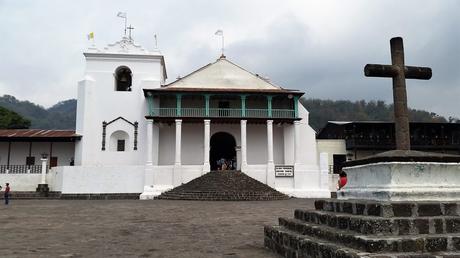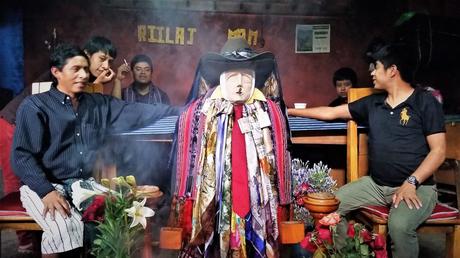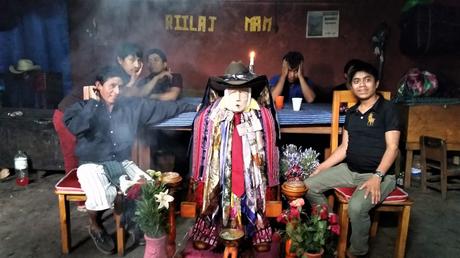Santiago Atitlan is the largest city on the banks of the famous Lake Atitlan in Western Guatemala. It has a large, thriving Mayan community and is significantly less touristy than most of the other Atitlan villages. However, it is a destination famous for one sight in particular: Maximon.
Maximon (pronounced mash-ee-mon) is a truly fascinating Mayan deity. Also known as San Simon or Rilaj Mam, he is a complex balance of benevolence and hedonism. He is believed to grant good fortune, health, and relationships to those who offer him booze, tobacco, and money.
The legends of Maximon's origin and meaning are complicated and largely passed down through oral-storytelling. As a result it is difficult to find a clear English-language description of the tale. By some accounts, Maximon was a drunken womanizer who was punished by townsmen for his sins. By other accounts he was a hero created to ward off evil who could not resist certain earthly temptations. Many people believe that he is some sort of blend of a Catholic saint with ancient Mayan beliefs.
No matter the origin story, Maximon is generally pictured in the same basic way: a carefree, bearded man sporting a bandit's bandana, a large sombrero, and a lit cigarette.
Even more mysterious and elusive than Maximon's background is the traditions surrounding him. In the cities where an effigy of Maximon is worshipped, his location traditionally changes on a yearly basis. Each year, he moves to a new shrine, or Cofradia. He is accompanied by loyal attendants or Cofradias, a band of men who spend the entire year watching over the altar. This generally means guiding the offerings and ceremonies, maintaining the candles and incense, and of course, keeping Maximon's cigarette lit.
Santiago Atitlan is home to perhaps the most famous Maximon effigy. But there's a twist: there are no signs, brochures, or websites tracking Maximon's location within Santiago. Unless you happen to witness the yearly parade that follows Maximon to his new home, there is only one way to find him: ask around.
An Egregious Offer
At least that's what we had been told. As soon as my boyfriend and I stepped off the boat in Santiago, a local man approached us offering to take us to Maximon. We were surprised to hear this and our hesitation encouraged him.
"I take you to Maximon." he said. "Only 200 quetzales."
That snapped me back to reality. My daily budget was $35, or roughly 250 quetzales. There was no way I was paying this man 200 quetzales to take me to a place I knew I could find on my own. We gave him a polite "no, thanks" and took off down the dock.
He wasn't backing down that easily. He chased after us as we began to steep ascent uphill into Santiago's town center. "Okay, 100 quetzales," he said. Then half a breath later: "50 quetzales."
I laughed. At this rate he'd soon be paying us to be our guide. We were warned that tourist scams abound in Santiago, including smaller shrines designed specifically for tourists. I waved him off again and we set off into town.

Searching for Maximon
We worked our way into the town center, weaving through the weekly market. We made our first ask of a fruit vendor.
"Gracias." I said to him as he handed me our mangos. "Y tengo una pregunta: ¿dónde está Maximon?" And I have a question - where is Maximon?
He looked at me for a second, seemingly bemused, and then pointed over my shoulder. He gave me some directions in rapid Spanish that I almost understood. It was enough, at least, to get started.
We began walking in the direction he pointed. Since there are no street names in Santiago, we were relying on something along the lines of "four blocks that way, then three blocks north."
When we had exhausted what we understood of the first directions, we stopped a man passing on the street and asked again. He pointed forward, in the same direction we were moving.
We asked one more silent pointer until we finally stopped in a shop to reevaluate our direction. The man working there pointed us back in the direction we had come. We turned on our heels and backtracked, beginning to fear that we were being led in circles.
Then finally, we struck gold. The next person we asked pointed us down an alley off the main street we were pacing. "Ahí" he said. There.
We turned where he pointed, excitement mounting. The narrow alley was barely large enough for a tuk-tuk, but it was far busier than many of the main streets we had been exploring earlier. Mayan women and children stared at us as we passed. Though Maximon is something of a tourist destination, it clearly wasn't every day that these people saw two white English speakers approaching the shrine alone.
It was clear when we reached the spot. The density of people had increased, many of them lining a narrow dirt path that broke off from the alley. Just as we arrived, a tuk-tuk pulled up from the opposite direction and a Mayan family spilled out. We followed the family down the dirt path one by one.
Cigarettes, Rum, and Incense: Inside the Cofradia
On the wall outside the Cofradia, there was a sign with suggested offerings. They suggested a nominal fee for entry, a few dollars to take a picture, and a much larger amount to purchase a bottle of quetzalteca, a sweet Guatemalan rum used for the Maximon ceremonies.
We entered and were hit by a wall of dense sticky air, fragrant with incense, flowers, and tobacco smoke. The room was dark and low-ceilinged, lit only by dozens of candles. A handful of Mayan men sat around a large wooden table against the back wall, their eyes heavy with rum and heat. In front of them, in the dead center of the room, stood Maximon.
The wooden effigy stood nearly four feet high and wore a wide-brimmed hat and dozens of colorful scarves tied around the neck. He was a cacophony of color and patterns. At his feet was a dish for offerings, but there were additional bills and flowers pinned to his scarves and hat. A burning cigarette hung from his open mouth.
As we entered we placed our entry fee and payment for a photograph at his feet. The C ofradias watched silently as I stepped back and snapped my picture, shaking with nervousness and awe. Then we stood in silence for a moment, observing the intense somber energy of the place.
The Maximon Ritual

A few seconds later the Mayan family entered behind us. Two men stepped forward, speaking quickly in the local language. They held out a 100 quetzales bill to the Cofradias. We realized that we were about to get very lucky; these men were making a full offering to Maximon.
One of the Cofradias came forward and pinned the money to Maximon's chest. He gestured at the ground in front of Maximon and the two men from the family knelt. The Cofradia open three flask-sized bottles of quetzalteca, handing one to each of the men.
He then began narrating a lengthy ceremony in the local dialect, saying prayers and waving incense over the two mens' heads. Then abruptly, he stopped, turned to Maximon, and took the cigarette out of his mouth.
He tilted Maximon backwards, said a few words, and poured the entirety of the third bottle of quetzalteca into Maximon's mouth.
Next, the two men making the offering downed their own bottles of rum in a few large gulps. They said a few more words, stood, and left the Cofradia.
We left shortly thereafter, awestruck, and made our way to the docks. It had been an exhausting and satisfying day. Nothing on my travels before or since has ever matched that afternoon with Maximon for an intense, intimate, and mysterious interaction with the Mayan culture.

Tips for Visiting Maximon
If you are visiting Santiago Atitlan I absolutely recommend trying to find Maximon. However, there are a few things to note before you head out on a trek to find the deity. Maximon is extremely important to the Cofradias and worshippers and it is important to be respectful of their traditions. Wear respectful clothing and pay the suggested visitation fee (the fees go towards supplies for the shrine and to sustaining the Cofradias).
Ask for directions to Maximon in Spanish and do not get upset if people are unwilling to help you. Remember that you may not be lucky enough to witness a ceremony when you visit. If you have room in your budget and want to make your own offering, consider hiring a guide (though perhaps not one straight from the docks). Even if you speak fluent Spanish you may not be able to speak with the Cofradias and you certainly will not understand what is happening during the ceremony. I recommend reading this guide to visiting Maximon; it has a few recommendations for local guides.
In short, be respectful, tenacious, and patient and you can witness this truly incredible part of Guatemalan and Mayan culture.
View more of my writing about Guatemala and Mayan culture on my blog Furiosities.

